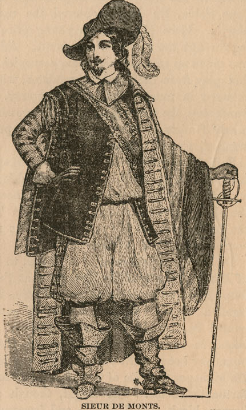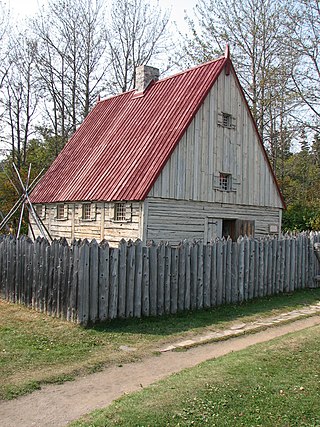This article needs additional citations for verification .(July 2017) |
| Part of a series on the |
| History of Canada |
|---|
 |
| Timeline (list) |
Contents |
| Historically significant |
| Topics |
| By provinces and territories |
| Cities |
| Research |
Events from the 1600s in Canada.
This article needs additional citations for verification .(July 2017) |
| Part of a series on the |
| History of Canada |
|---|
 |
| Timeline (list) |
Contents |
| Historically significant |
| Topics |
| By provinces and territories |
| Cities |
| Research |
Events from the 1600s in Canada.
![Plaque honouring the first settlers of Quebec City. (Affixed to back of monument to Guillaume Couillard [fr], which accompanies those to Louis Hebert and Marie Rollet.) Parc Montmorency, Quebec City. Plaque des premiers colons de Quebec.jpg](http://upload.wikimedia.org/wikipedia/commons/thumb/f/f6/Plaque_des_premiers_colons_de_Quebec.jpg/220px-Plaque_des_premiers_colons_de_Quebec.jpg)

Samuel de Champlain was a French explorer, navigator, cartographer, draftsman, soldier, geographer, ethnologist, diplomat, and chronicler. He made between 21 and 29 trips across the Atlantic Ocean, and founded Quebec City, and New France, on 3 July 1608. An important figure in Canadian history, Champlain created the first accurate coastal map during his explorations and founded various colonial settlements.

France began colonizing the Americas in the 16th century and continued into the following centuries as it established a colonial empire in the Western Hemisphere. France established colonies in much of eastern North America, on several Caribbean islands, and in South America. Most colonies were developed to export products such as fish, rice, sugar, and furs.

New France was the territory colonized by France in North America, beginning with the exploration of the Gulf of Saint Lawrence by Jacques Cartier in 1534 and ending with the cession of New France to Great Britain and Spain in 1763 under the Treaty of Paris.

This section of the timeline of New France history concerns the events between Jacques Cartier's first voyage and the foundation of the Quebec settlement by Samuel de Champlain.

This section of the Timeline of Quebec history concerns the events between the foundation of Quebec and establishment of the Sovereign Council.
Saint Croix Island, long known to locals as Dochet Island, is a small uninhabited island in Maine near the mouth of the Saint Croix River that forms part of the Canada–United States border separating Maine from New Brunswick. The island is in the heart of the traditional lands of the Passamaquoddy people who, according to oral tradition, used it to store food away from the dangers of mainland animals. The island was the site of an early attempt at French colonization by Pierre Dugua, Sieur de Mons in 1604. In 1984 it was designated by the United States Congress as Saint Croix Island International Historic Site. There is no public access to the island, but there is a visitor contact station on the U.S. mainland and a display on the Canadian mainland opposite the island.

The 16th century in Canada saw the first contacts, since the Norsemen 500 years earlier, between the indigenous peoples in Canada living near the Atlantic coast and European fishermen, whalers, traders, and explorers.

Events from the 1610s in Canada.

Pierre Dugua de Mons was a French merchant, explorer and colonizer. A Calvinist, he was born in the Château de Mons, in Royan, Saintonge and founded the first permanent French settlement in Canada. He was Lieutenant General of New France from 1603 to 1610. He travelled to northeastern North America for the first time in 1599 with Pierre de Chauvin de Tonnetuit.

Port-Royal National Historic Site is a National Historic Site located on the north bank of the Annapolis Basin in Granville Ferry, Nova Scotia, Canada. The site is the location of the Habitation at Port-Royal, which was the centre of activity for the French colony of Port Royal in Acadia from 1605 to 1613 when it was destroyed by English forces from the Colony of Virginia.

The Company of One Hundred Associates, or Company of New France, was a French trading and colonization company chartered in 1627 to capitalize on the North American fur trade and to expand French colonies there. The company was granted a monopoly to manage the fur trade in the colonies of New France, which were at that time centered on the Saint Lawrence River valley and the Gulf of Saint Lawrence. In return, the company was supposed to settle French Catholics in New France. The Company of One Hundred Associates was dissolved by King Louis XIV, who incorporated New France into a province in 1663.

Louis Hébert is widely considered the first European apothecary in the region that would later become Canada, as well as the first European to farm in said region. He was born around 1575 at 129 de la rue Saint-Honoré in Paris to Nicolas Hébert and Jacqueline Pajot. He loved another woman but according to his father's wish he married Marie Rollet on 19 February 1601 at the Church of Saint-Sulpice, Paris.

The Order of Good Cheer was originally a French Colonial order founded in 1606 by suggestion of Samuel de Champlain. A contemporary order awarded by the Province of Nova Scotia bears the same name in continuance of the original order.
Charles de Saint-Étienne de La Tour (1593–1666) was a Huguenot French colonist and fur trader who served as Governor of Acadia from 1631–1642 and again from 1653–1657.
Events from the year 1609 in Quebec.
François Gravé, said Du Pont, was a Breton navigator, an early fur trader and explorer in the New World.

Pierre de Chauvin de Tonnetuit was a French naval and military captain and a lieutenant of New France who built at Tadoussac, in present-day Quebec, the oldest and strongest surviving French settlement in the Americas.

Fort Ville-Marie was a French fortress and settlement established in May 1642 by a company of French settlers, led by Paul de Chomedey de Maisonneuve, on the Island of Montreal in the Saint Lawrence River at the confluence of the Ottawa River, in what is today the province of Quebec, Canada. Its name is French for "City of Mary", a reference to the Blessed Virgin Mary.

Port Royal (1605–1713) was a historic settlement based around the upper Annapolis Basin in Nova Scotia, Canada, and the predecessor of the modern town of Annapolis Royal.

The Battle of Sorel occurred on June 19, 1610, with Samuel de Champlain supported by the Kingdom of France and his allies, the Huron, Algonquin people, and Montagnais that fought against the Mohawk people in New France at present-day Sorel-Tracy, Quebec. The forces of Champlain armed with the arquebus engaged and killed or captured nearly all of the Mohawks. The battle ended major hostilities with the Mohawks for twenty years.